Gayle Irwin's Blog, page 20
September 19, 2017
separation anxiety in dogs
 More than a week has passed since my husband and I adopted “Stormy,” renamed “Jeremiah.” Overall, considering all the changes the little guy has gone through in this short amount of time, he is doing well. He certainly knows I’m his caregiver! Not a bad thing… except when I leave the house. Then, he whimpers, barks, and howls. He may be developing separation anxiety.
More than a week has passed since my husband and I adopted “Stormy,” renamed “Jeremiah.” Overall, considering all the changes the little guy has gone through in this short amount of time, he is doing well. He certainly knows I’m his caregiver! Not a bad thing… except when I leave the house. Then, he whimpers, barks, and howls. He may be developing separation anxiety.According to both the American Kennel Club (AKC) and the American Society for the Prevention of Cruelty to Animals (ASPCA), separation anxiety can occur in dogs who experience a change in guardianship or family. Dogs which come from shelters and rescues, as Jeremiah did, become accustomed to certain caregivers while living at Hearts United for Animals, and since I’m the primary caregiver to our pets (feeding, going outside to potty, etc.), he prefers I be in sight. Sometimes he even whines when I’m just downstairs doing laundry!
Separation anxiety can be mild or severe. Behaviors range from barking and pacing to going potty in the house and destroying furniture and clothing.
There are many counterconditioning activities a pet parent can implement to desensitize a dog to its human leaving. An article on the ASPCA’s website advises, “For dogs with separation anxiety, counterconditioning focuses on developing an association between being alone and good things, like delicious food. To develop this kind of association, every time you leave the house, you can offer your dog a puzzle toy stuffed with food that will take him at least 20 to 30 minutes to finish.” Recommendations for such toys include KONG; not only are these toys nearly indestructible, but they also provide opportunities for your dog to enjoy a treat while you are gone and also get some good exercise. Try this for short trips at first, such as going to the grocery store, can help prepare your dog for your long away-times, such as school or work. Read the entire ASPCA article on separation anxiety here, including recommendations for more severe cases of the behavior: https://www.aspca.org/pet-care/dog-care/common-dog-behavior-issues/separation-anxiety.
Jeremiah and our other dog Mary get along well; I often find him curled up next to her or at least within close proximity. Having our other dog around helps him, but not enough to keep him from carrying on when I’m gone. Needless to say, I’ll be working on some of these counterconditioning ideas recommended by the ASPCA!
Have you had a dog with separation anxiety? What did you do to help your four-footed friend not be so anxious in your absence?

Published on September 19, 2017 05:00
September 12, 2017
The Horrors of Puppy Mills and the Heroes Who Help the Dogs
 He never knew the inside of a house. He rarely had opportunity to play with toys. He’s unfamiliar with leashes and walking the neighborhood, and his housetraining is limited. His name was Stormy.
He never knew the inside of a house. He rarely had opportunity to play with toys. He’s unfamiliar with leashes and walking the neighborhood, and his housetraining is limited. His name was Stormy.One year ago, the then-three-year-old Shih Tzu was one of dozens of dogs rescued from the squalor of a puppy mill. Staff and volunteers at Hearts United for Animals have a mission – to rescue, work with, and re-home as many puppy mill dogs as they can. They also take in dogs and cats for other reasons, such as deaths in the family, and they help owners keep their pets who might have to give them up due to the animal’s medical condition. Nearly 400 animals reside at the rural Nebraska animal sanctuary, many of them small breeds like Stormy. But, there are also larger dogs, such as Hounds, Labs, and Shiba Inus. Other organizations, such as National Mill Dog Rescue in Colorado, have a similar mission: closing puppy mills by rescuing the oppressed, neglected animals and bringing new life and hope to those creatures.
What is a Puppy Mill?
According to the American Society for the Prevention of Cruelty to Animals (ASPCA), a puppy mill is “a large-scale commercial dog breeding facility where profit is given priority over the well-being of the dogs. Puppy mills usually house dogs in overcrowded and unsanitary conditions without adequate veterinary care, food, water or socialization. In order to maximize profits, female dogs are bred at every opportunity with little-to-no recovery time between litters.” The pups are sold in pet stores, over the Internet, through newspaper ads, and at swap meets and flea markets. Because millers focus on making money, the dogs are often bred with little regard for genetic quality, and therefore, the puppies are often ill or have significant health issues. There is no oversight to this industry, and though there is no real data to know the number of millers in the U.S., the ASPCA estimates there are about 10,000 puppy mills in America.
The Humane Society of the United States also rescues and shuts down puppy mills. Learn more about their operations at http://www.humanesociety.org/issues/campaigns/stop_puppy_mills/?credit=web_id93480558.
New Life, New Hope
Stormy now has a new life – and a new name. Jeremiah Story Irwin is the new four-footed family member in my house. He, and other puppy mill survivors (and their rescuers) have a story, and I write stories, therefore, his middle name. A few weeks before his first anniversary with HUA, Jeremiah now lives in a house for the first time in his life, has other animal friends (although the original Irwin resident pets are still getting used to the idea of a new housemate!), and has a large backyard to explore. The first time he accepted a toy and trotted around the house with it brought tears to my eyes. There are challenges, such as housetraining, but he’s catching on quickly, and he’s already learned the commands of sit and come – in less than a week. He’s a smart, loving, happy boy, and I’m thankful we found each other! I am also thankful to the heroes who help puppy mill dogs escape the horrors of their previous lives!
Adopt, Don’t Shop! And encourage your friends and family to do so. By those actions, you, too, can impact (and change) the lives of puppy mill dogs, giving them hope, love, and joy.
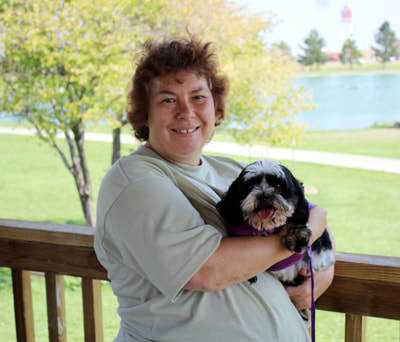
Published on September 12, 2017 06:06
September 5, 2017
a rose by any other name
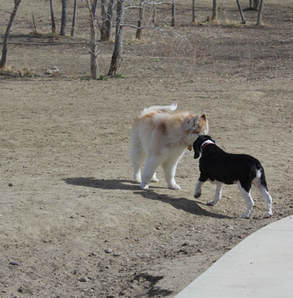 What’s in a name? Most names have meaning, and many times people seriously consider the name they give a child. Many pet parents also genuinely think about the name they bestow upon their animal, especially when the pet is adopted.
What’s in a name? Most names have meaning, and many times people seriously consider the name they give a child. Many pet parents also genuinely think about the name they bestow upon their animal, especially when the pet is adopted.A Dog Named Stormy
My husband and I are in the process of adopting another dog, and we are seriously thinking about names. Currently, the dog is named Stormy, and although that’s not a bad name, the little guy (a Shih Tzu) was rescued from a puppy mill situation by a non-profit animal welfare group. We think he deserves a new name: he has a new life, he’ll be starting over in a loving home with us, and truthfully, I don’t want my dog named after a natural force that can kill (he’s not a police or military dog after all!). So, we are discussing names. I even asked friends for their input, and, after seeing Stormy’s picture, many expressed their thoughts. My husband has his ideas for a new name for our new pet, and so do I. We will take a list of the names we’ve compiled, both our own favorites and the thoughts of pet-loving friends, and we will bring those ideas with us to the adoption center.
When we meet Stormy and have time to spend with him, including a several-hour drive back home, we’ll see which new name appears to “fit” him. Will it be Spencer? Or Ozzie? Or Ranger? Perhaps Beau. Or Teddy. Or maybe even Story – he has a story, and I write stories… but my husband frowned at that one (just as I frowned at Ozzie).
Popular Pet Names
There’s a lot of advice out there about naming your pet, whether dog or another animal. One of the best pieces of advice I’ve followed is to keep a name short and easy to say, and therefore, easy to understand. Another is to not name your pet after something that sounds like a command, such as “Joe,” which could be misinterpreted as “no,” or “Kit,” which could be heard as “sit” (or something far worse, especially if you’re yelling that name across the dog park!)
There are hundreds of popular names for pets, both dogs and cats. Some trendy feline names include Bella, Coco, and Jasper. See here:
The American Kennel Club (AKC) provides a listing of the People names are popular for dogs, such as Sam, Henry, and Chloe.Some dogs are named after a specific ethnicity, such as Irish (Seamus, Finn, and Maeve).Popular hunting dog breed names include Scout, Gunner and, of course, Hunter.Some animal names are old-fashioned: Franklin, Barkley, and Elliot.Large breed dogs tend to have names to make you think twice about approaching that dog: Brutus, Maximus, and Atticus.Some dogs are named after movie/TV characters, like Starsky, Benji, and Sherlock.Some are named after
Keep the Name or Change It?
I’ve usually kept my dog’s name short and sweet: Sam; Cody; Sage; Mary. All of them had their names already except for Sam – he was a stray whom no one knew anything about. But, he caught on to that name quickly and we enjoyed a decade together with a deep, close connection. I kept the other dogs’ name the same because, at least in Sage and Mary’s cases, their situations weren’t dire or so traumatic that I believed a change was necessary. And, Cody was nearly 10 years old when we adopted him, so neither my husband nor I thought it worthwhile to change his name; he was totally used to it, and again, it was short and easy to say. My cats – well, the two remaining with us were kittens when we adopted them so we could name them as we wanted (Murphy and Bailey); my husband comes from Irish ancestry, and I enjoy Irish culture, so we chose names to reflect that (plus those names that end in “y” seem popular and easy to understand). My other cat, Ama, was already named and it was so unique, I decided to keep it.
How about you? Do you keep a pet’s name when you adopt or do you change it? What do you take into consideration when naming your animals?

Published on September 05, 2017 05:00
August 29, 2017
helping pets during a disaster
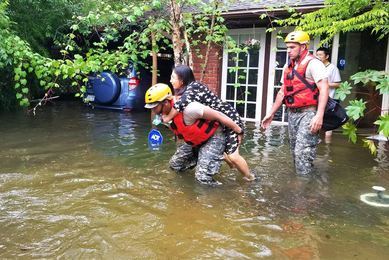 As pictures unfolded the past several days of destruction from Hurricane Harvey along the Texas coast and the sky’s open spigot drenching Houston with floodwater devastation, one could not help but wonder about the people and animals impacted by this natural disaster.
As pictures unfolded the past several days of destruction from Hurricane Harvey along the Texas coast and the sky’s open spigot drenching Houston with floodwater devastation, one could not help but wonder about the people and animals impacted by this natural disaster.Hurricanes, tornadoes, fires, floods -- every year the United States and other countries feel the assault of such forces. And, every year, rescue organizations, from the American Red Cross to the ASPCA, respond to people and pets in crisis. Sometimes the images and realities are overwhelming – who can forget Hurricane Katrina and New Orleans? These are the times when I, at least, wish I’d won the lottery and could pump millions of dollars into the organizations that respond to natural disasters.
Two recently published articles helps us understand the situation:
https://www.yahoo.com/news/owners-rescue-dogs-houston-plunges-chaos-125302245.html
http://news.nationalgeographic.com/2017/08/dogs-harvey-hurricane-pets-cats/
But, I don’t have millions. I don’t have thousands. I really don’t even have hundreds. And, I imagine most people are in the same boat, so to speak. So, how can we respond? How can we help?
Look around at the resources we do have. Can we purchase an extra bottle of laundry detergent or give up a cup of coffee at the local drive-through on our way to work? Donations, of supplies or money (even if it’s $5 or $10) can go a long way, partnering with other small donations.
As an author, I have another resource – my books: they are about pets. And, I can encourage a fundraising campaign, giving books to those who donate to Hurricane Harvey pet rescue endeavors. That’s what I’ve decided to do.
National Dog Day was Saturday, about the time Hurricane Harvey hit Texas. In honor of dogs, and helping those in need impacted by this major storm, I’ll give a book to anyone who requests one after they have donated to a pet rescue organization helping animals displaced by Hurricane Harvey. Groups such as the ASPCA, Best Friends Animal Society, Humane Society of the United States, and Austin Pets Alive! are participating in the pet rescue endeavors (you can learn more through the links I’ve provided here).
Email me a copy of the receipt (or some other type of confirmation) that you receive from your donation to one of these groups (or one of your choice that is helping the animals displaced by the hurricane and Houston’s flooding), and I’ll send you a book for free! My email address is waggintaleswyo@gmail.com. Keep the book for yourself or give to a friend, child, or grandchild. My inspirational stories weave wonderful life lessons and showcase how pets can teach us amazing things.
Many of the pictures we’ve seen have also been inspirational: people helping one another, coming together in community, saving lives, providing hope. That’s what we can do here: provide hope, let others know we care. When our hearts are broken by the images of ravaging flood waters, dogs swimming in feet of water, trying to survive, hurricane damage to businesses and homes, people atop house roofs waiting to be rescued … we wonder what we can do.
I donated yesterday to Austin Pets Alive! with some of the book sale funds I received from events last weekend. I hope you’ll help me help pets affected by this crisis. The book offer will continue through September 15, when I’ll be bringing my new furry friend home (my husband and I are adopting a dog in a few weeks – more about that exciting news in next week’s blog).
Won’t you join me in helping pets affected by this month’s natural disaster? In addition to the book, I will also provide you with a FREE monthly pet-oriented newsletter, which you can also share with your pet-loving family and friends.
Thank you for doing what you can to help people and pets affected by this disaster – I look forward to partnering with you in this endeavor!
 ORGANIZATIONS HELPING TEXAS ANIMALS:
ORGANIZATIONS HELPING TEXAS ANIMALS:Below are links to some of the animal rescue groups helping the animals in Texas:
https://www.austinpetsalive.org/hurricane-harvey-evacuations/
https://secure.humanesociety.org/site/Donation2?df_id=22819&22819.donation=form1&s_src=web_hpbb_082717_d_id93480558
https://support.bestfriends.org/site/Donation2;jsessionid=00000000.app294a?df_id=1820&1820.donation=form1&mfc_pref=T&s_src=WDE08171ERGCOOOO&utm_medium=email&utm_source=luminate&utm_campaign=harvey&NONCE_TOKEN=F4E94341F3CBAA65D75B223F7DAB151D
https://secure.aspca.org/donate/2017-web-har-bre1-T1-P1?ms=wb_hom_position1-har-bre1-20170828&initialms=wb_hom_position1-har-bre1-20170828&pcode=WEB1HOM&lpcode=WEB2HOM
Published on August 29, 2017 05:19
August 22, 2017
Cooking for your pet
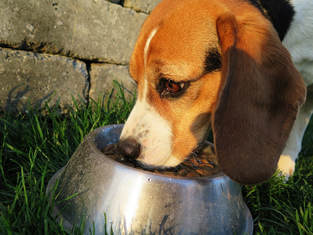 Your pet is your best friend, always giving you endless love and (sometimes slobbery) kisses. While your furry friend enjoys playing with toys and sleeping on a soft bed, there is one thing your pet loves as much as you: food! Although kibble is acceptable, it’s time to treat your best friend to something yummy and delicious.
Your pet is your best friend, always giving you endless love and (sometimes slobbery) kisses. While your furry friend enjoys playing with toys and sleeping on a soft bed, there is one thing your pet loves as much as you: food! Although kibble is acceptable, it’s time to treat your best friend to something yummy and delicious.With so many pet food and treat recalls during the past few years, many people are turning to, or considering using, homemade dog and cat food and treats. There are pluses and minuses: the major plus is that you know for sure what you’re feeding your pets; the minuses include time to prepare/cook and ensuring your furry one is receiving the proper nutrition it needs.
Barbara Laino, the author of "The Healthy Homemade Pet Food Cookbook" and owner of an organic farm in New York, teaches people how to make quality dog and cat food (she also teaches how to make better people food as well). She says the foundation for a good pet food diet is variety.
“I believe much of the recent food allergy problem has developed from feeding the same thing every day,” says Laino. “Yet, this is probably one of the most controversial parts of the homemade diet. Somehow it has reached the point that people are scared they can’t balance their dog’s food properly.”
Raw diet vs. cooked food is another debated concept. To this thought, Laino says, “I think people get hooked on the raw concept, but it’s not all about raw. Whatever you feel comfortable with, whether it’s boiling chicken breasts or grinding raw chicken necks … any time you’re preparing food using fresh ingredients, it’s going to be a thousand times better than what you’re getting from kibble.”
Budget and time can be a constraint for pet owners. Laino says there is a way to improve your pet’s health without going totally to homemade food.
“You can take a scoop of good kibble and combine it with carrots, honey or a whole egg,” she explains. “Another one is canned salmon, which is super-easy and convenient. If you do nothing else, add a little canned salmon to your dog’s kibble every day. It’s one of the healthiest things you can do.”
Keep in mind, however, that changing your pet’s diet shouldn’t be done abruptly. Introduce new foods slowly, whether that be raw, homemade cooked, or even a new brand of commercial bagged or wet food.
Learn more about creating homemade pet food at these websites:
http://thebark.com/content/10-myths-and-misperceptions-about-homemade-dog-food
https://www.whole-dog-journal.com/issues/15_7/features/Home-Prepared-Dog-Food-Nutritional-Information_20568-1.html
https://iheartcats.com/5-benefits-to-feeding-your-cat-a-raw-food-diet/
Treats for pets are often seen on a recall list. The latest are rawhide chews for dogs. You can make pet treats at home, once again being sure of the ingredients in the goodies. Here are three websites to visit for homemade treat recipes:
For Dogs: http://www.personalcreations.com/blog/dog-treat-recipes
and
https://www.cesarsway.com/dog-care/nutrition/recipes-for-quick-and-healthy-dog-treats
For Cats: https://iheartcats.com/5-easy-diy-cat-treat-recipes/
Ensure your pet isn’t eating the wrong things by cooking for your pet and controlling what ingredients go into your furry friend’s food and treats.
Additionally, keep track of recent pet food recalls by visiting this website periodically if you do continue to feed commercial kibble and wet food to your pet: https://www.avma.org/news/issues/recalls-alerts/pages/pet-food-safety-recalls-alerts.aspx
This site shows dog food and treat recalls: https://www.dogfoodadvisor.com/dog-food-recalls/
This web page shows the cat food recalls as well as dog food recalls: http://www.petful.com/recall-lists/cat-food-recalls/
Our pets depend on us for nutrition, fun, and safety, so let us pet parents do our best to safeguard their health.
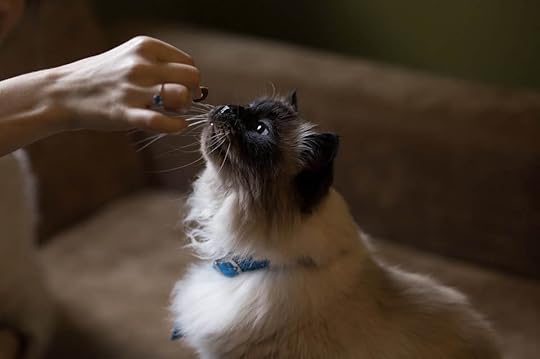
Published on August 22, 2017 05:00
August 15, 2017
Animals and the solar eclipse
 On Monday, August 21, people will be watching the skies, especially in areas like Casper, Wyoming (where I live) as a total solar eclipse appears. Those of us who enjoy animals may wonder what pets and other creatures will do in response to the eclipse.
On Monday, August 21, people will be watching the skies, especially in areas like Casper, Wyoming (where I live) as a total solar eclipse appears. Those of us who enjoy animals may wonder what pets and other creatures will do in response to the eclipse.Most of us know animals respond to natural phenomenon, such as earthquakes. According to the U.S. Geological Survey, animals seem to sense the onslaught of an earthquake. And, many pet owners know their dogs become anxious during thunderstorms.
According to a report from National Geographic and other sources, animal behavior during an eclipse is not well documented due to the rarity of such an event. However, the organization reports that in other eclipses, “Dairy cows return to the barn, crickets begin chirping, birds either go to roost or become more active, and whales breach in the seas.”
During the upcoming eclipse, an ecologist at the California Academy of Sciences, Rebecca Johnson, is seeking to improve the scientific record regarding animal behavior and solar eclipses. She has helped create the Life Responds project, which runs on a SmartPhone app called iNaturalist. The Nat Geo article states, “Her team of biologists and astronomers will use the app to collect data from the millions of people who will witness the eclipse on August 21. The hope is that the Life Responds app will create a meaningful clearinghouse for animal behavior during eclipses that scientists can use to advance their research.”
Staff and volunteers at zoos across the country will also be observing behaviors of the animals living in these facilities. An article from CNN states that the Tennessee Aquarium in Chattanooga plans to carefully observe its lemurs. “There is evidence from past eclipses that lemurs ‘behave oddly during these events,’ according to Thom Benson, the aquarium's director of external affairs.” Additionally, Chicago’s Lincoln Park Zoo “is betting something could happen with its collection of chimps, which it will be watching closely.”
Watch a video on NASA’s website about llamas’ and whale responses to past eclipses: Video about llamas and marine mammals: https://eclipse2017.nasa.gov/animals-total-eclipse.
As far as our pets, we may or may not observe and/or hear much of anything. The CNN article goes on to say, “A study from the 1970s found that pet rabbits mostly slept. A few caged birds got agitated. Some dogs ignored the eclipse; a few seemed scared; a few barked when it was over. Cats, well, cats were cats. Some played, some meowed, but for the most part they slept, again showing off their best quality, as anyone who owns a cat knows: Our feline friends think the sun and the moon revolve around them, so what's the big deal about a little more shade?”
Another article, published on Quartz, quotes Bryant Buchanan, a biologist who studies nocturnal animals at Utica College in New York: “Then, of course, as light levels increase any dusk activated genetic activity will move into daylight genetic activity. It’s hard to imagine that the eclipse would have much more of an effect than temporary confusion.”
So, how will the animals around us, including our pets, respond to Monday’s solar eclipse? Perhaps those of us observing the sky can also take a bit of time to watch and listen to nature and our pets and participate in the Life Responds project, becoming scientists in our own communities, adding to the public knowledge.

Published on August 15, 2017 05:00
August 8, 2017
Celebrating dogs in many ways
 Mothers have their special day in May; fathers have their special day in June. Grandparents have their special day in September, and dogs have their special day this month! August is known for the Dog Days of Summer – often hot, and many times muggy – but it’s not just weather which brings out a special recognition. Dogs around the country have their own special day in August. Each August 26 since 2004 organizations and individuals around the country have celebrated National Dog Day.
Mothers have their special day in May; fathers have their special day in June. Grandparents have their special day in September, and dogs have their special day this month! August is known for the Dog Days of Summer – often hot, and many times muggy – but it’s not just weather which brings out a special recognition. Dogs around the country have their own special day in August. Each August 26 since 2004 organizations and individuals around the country have celebrated National Dog Day.Started by author and pet lifestyle expert Colleen Paige, National Dog Day was first developed to honor the search and rescue dogs of September 11th. Ms. Paige then turned her attention to the millions of dogs in need of loving, forever homes, and expanded her mission to include encouragement of pet adoption. (see the National Dog Day website: http://www.nationaldogday.com/).
We, too, can celebrate dogs in both a community way and a personal way. Volunteering at the local shelter is a great way to honor National Dog Day, as a family, group, or individual: walking dogs, playing with cats, helping to clean up the area around the shelter, even taking a group of Scouts or other people for a “handyman project” at the facility. In a personal way, do something extra special for and/or with your beloved pet: take a pet-friendly vacation; buy a pet first aid kit; hire a pet photographer to capture a “family portrait;” microchip your dog for its safe return should it become lost. There are numerous ways to celebrate the special dog in your life!
Today, two new Chicken Soup for the Soul books about pets are released: one about dogs, the other about cats. These books particularly advocate the adoption of pets, with a portion of sale proceeds going to the American Humane Association. I have a story in the dog book The Dog Really Did That? about a dog I helped transport for a Colorado-based rescue group. One way I celebrate dogs is to write about them (see my website for the various inspirational pet books for children and adults); this Chicken Soup story, “Jazmine’s Journey,” is my seventh published work for Chicken Soup for the Soul. I’m honored to have several of my stories about pets, mostly rescue/shelter animals, in this internationally-recognized book collection!
Another way I celebrate dogs is to help my local and regional rescue groups through events and transportation needs. I transport for several groups, including Big Dogs Huge Paws and Mid-America Boston Terrier Rescue. And, I donate a percentage of my book sales to area pet rescue organizations.
Another way I celebrate dogs is to take care of my own pets in a variety of ways, and when the time comes to add another furry friend to the household, I adopt through a shelter or rescue. I’m seriously looking now for a new furry friend; my sweet cocker spaniel Cody has been gone for nearly 18 months. Several days a week I spend time searching for that “special someone” and when the opportunity arises for just the right dog (we are a multi-pet household), I will adopt a new four-footed friend.
There are many ways to celebrate the dogs in our lives and to help local, regional, and national animal rescue groups. Whether you donate needed supplies to your local shelter, assist in transporting animals for a regional rescue, or contribute money to a national group (even through purchasing the newly released Chicken Soup for the Soul: The Dog Really Did That? or The Cat Really Did That?) or adopt from a shelter or rescue, you are helping dogs in need. And, you can celebrate your special dog every day simply by just being your pup’s best friend!
As the Dog Days of Summer engage, celebrate the incredible loyalty, friendship, and courage dogs give in your own special way.

Published on August 08, 2017 05:00
August 1, 2017
Fleas, Ticks, and Tiny Other Pests – Oh, My!
 While walking through Montana woodlands last weekend with my friend and her dog, I pondered the tiny pests which can affect we humans and our animals. Just thinking of the possibility of ticks made my neck itch that day! Although it’s fun to hike and saunter the woodlands with our pets during summer, there are several tiny, nasty pests which can affect the enjoyment of such activities.
While walking through Montana woodlands last weekend with my friend and her dog, I pondered the tiny pests which can affect we humans and our animals. Just thinking of the possibility of ticks made my neck itch that day! Although it’s fun to hike and saunter the woodlands with our pets during summer, there are several tiny, nasty pests which can affect the enjoyment of such activities.During this season of the year, many of our beloved animals spend more time outside. Running through grass, exploring forests, and encountering other pets while outdoors can bring your pet into contact with fleas and ticks. These tiny creatures can cause plain irritation as well as great harm to dogs and cats. According to Web MD, fleas, though tiny, can eat 15 times their own weight in blood, causing anemia in a dog or cat. Fleas cause itching and are known to be the most common cause of pet skin disease. Ticks, when not removed properly, can bring Lyme disease and Rocky Mountain Spotted Fever to both animals and people.
Various preventive programs curb fleas and tick exposure, and therefore, a pet parent's worry. Talk with your veterinarian about how to prevent these tiny pests from infecting and affecting your dog or cat. You can purchase preventive measures from your vet directly or from a local pet supply store. You may also want to consult the Pet MD website for more information on fleas and ticks, which includes a Flea and Tick Survival Guide: http://www.petmd.com/flea-tick-survival-guide#. Learn more about fleas and ticks and their impact on pets at http://pets.webmd.com/ss/slideshow-flea-and-tick-overview.
Ticks and fleas aren’t the only miniscule pests which pet parents should be concerned about. Mosquitoes also pester animals as well as people. Fur provides some protection, but ears and noses are vulnerable. Living and spending time near a water source makes you and your furry friend more susceptible to swarms of mosquitoes; therefore, use protection from these blood-suckers. Mosquitoes can carry West Nile Virus as well as heartworm, a major disease affecting dogs; cats can get the disease as well. View heartworm incident maps at https://www.heartwormsociety.org/pet-owner-resources/incidence-maps. Therefore, protect your pet from mosquitoes. Dogs and cats can be allergic to tiny problematic creatures like ticks and mosquitoes – another a good reason to protect them from these pesky pests!
Other small pests which can affect the enjoyment of summer for people and their pets include biting flies and gnats. These little creatures may also carry disease. Therefore, protect yourself and your pets from them as well.
Being outdoors during summer is fun for us and our pets, particularly our dogs. But remember, there are tiny creatures out there just waiting for a warm body, ours and our animals, on which to inhabit. Therefore, take the needed precautions and purchase those preventative remedies to keep your beloved pet from being infected by fleas, ticks, mosquitoes and other tiny, pesky pests. Talk with your veterinarian about how to keep your furry friend safe and healthy this summer.

Published on August 01, 2017 05:30
July 25, 2017
pets and water - not always a good mix
 With summer’s sweltering temperatures ravaging much of the United States, people and pets want to find ways to cool off. Perhaps a dip in the pool, a sojourn to a nearby lake, or wading in a creek or river – these can be fun activities. But, when it comes to pets and water, there are a few things to keep in mind:Swimmer? Not always. Not all dogs are natural-born swimmers, therefore, investing in a floatation device (life-jacket) for your dog is a good idea, especially for trips to lakes. Water depth is steep in these spots so keep your pet safe with a specially-designed life jacket, and keep the life jacket on your pet just as you do a child while in the boat.Algae awareness. Stay away from ponds and lakes with blue-green algae – the algae contains bacteria that can make your pet very ill and even cause death. Therefore, animals shouldn’t drink or even swim in waterways with blue-green algae. Read more about this toxin here: http://healthypets.mercola.com/sites/healthypets/archive/2017/06/14/toxic-blue-green-algae.aspx.Beware of ocean hazards. Watch out for strong currents and riptides that pull you and your pooch out to sea. Also, be aware that objects like sharp rocks, shells, coral, and jellyfish can also injure you as well as your four-footed beach buddy.Don’t drink the water! Also, don’t let your pet drink ocean water –your furry friend can become ill. Salt water is unsafe for either people or pets to drink.Take precautions with your pool. If you have a pool, make sure your dog knows how to get in and out. Even steps into and out of a pool can be very slippery for an animal and your pet may panic and drown while trying to get out. If you have a pool at your house and you have pets, consider investing in a Scamper Ramp, which helps pets safety get out of the pool. Also, read this interesting article of another escape ramp called the Frog Log, created for small animals: https://www.goodnewsnetwork.org/genius-invention-saving-dozens-animals-drowning/. It’s a good idea also to keep your pool covered so animals and children don’t accidentally fall in and possibly drown. Find more water safety tips at http://pets.webmd.com/dogs/pets-water-safety#1,
With summer’s sweltering temperatures ravaging much of the United States, people and pets want to find ways to cool off. Perhaps a dip in the pool, a sojourn to a nearby lake, or wading in a creek or river – these can be fun activities. But, when it comes to pets and water, there are a few things to keep in mind:Swimmer? Not always. Not all dogs are natural-born swimmers, therefore, investing in a floatation device (life-jacket) for your dog is a good idea, especially for trips to lakes. Water depth is steep in these spots so keep your pet safe with a specially-designed life jacket, and keep the life jacket on your pet just as you do a child while in the boat.Algae awareness. Stay away from ponds and lakes with blue-green algae – the algae contains bacteria that can make your pet very ill and even cause death. Therefore, animals shouldn’t drink or even swim in waterways with blue-green algae. Read more about this toxin here: http://healthypets.mercola.com/sites/healthypets/archive/2017/06/14/toxic-blue-green-algae.aspx.Beware of ocean hazards. Watch out for strong currents and riptides that pull you and your pooch out to sea. Also, be aware that objects like sharp rocks, shells, coral, and jellyfish can also injure you as well as your four-footed beach buddy.Don’t drink the water! Also, don’t let your pet drink ocean water –your furry friend can become ill. Salt water is unsafe for either people or pets to drink.Take precautions with your pool. If you have a pool, make sure your dog knows how to get in and out. Even steps into and out of a pool can be very slippery for an animal and your pet may panic and drown while trying to get out. If you have a pool at your house and you have pets, consider investing in a Scamper Ramp, which helps pets safety get out of the pool. Also, read this interesting article of another escape ramp called the Frog Log, created for small animals: https://www.goodnewsnetwork.org/genius-invention-saving-dozens-animals-drowning/. It’s a good idea also to keep your pool covered so animals and children don’t accidentally fall in and possibly drown. Find more water safety tips at http://pets.webmd.com/dogs/pets-water-safety#1,http://www.petsmart.com/learning-center/dog-care/water-safety-tips-for-dogs/A0161.html,
and
http://blog.gopetfriendly.com/keeping-your-dog-safe-at-the-beach/.

Published on July 25, 2017 05:00
July 18, 2017
caring for your senior cat
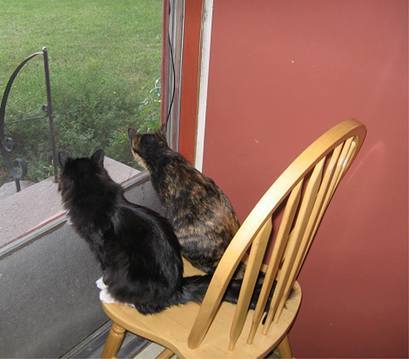 In just a few short weeks, my two cats, Murphy and Bailey, will turn 12 years of age. They are sisters, even though they look nothing alike. My husband and I adopted them when they were about 10 weeks old, being born of a feral mother who allowed herself to be taken into a friend’s home a few days prior to giving birth; it was like Mamma knew she needed to be somewhere safe to protect her newborns. Everyone received a new home, and on August 1, our two girls will become even more “senior” at the ripe age of 12.
In just a few short weeks, my two cats, Murphy and Bailey, will turn 12 years of age. They are sisters, even though they look nothing alike. My husband and I adopted them when they were about 10 weeks old, being born of a feral mother who allowed herself to be taken into a friend’s home a few days prior to giving birth; it was like Mamma knew she needed to be somewhere safe to protect her newborns. Everyone received a new home, and on August 1, our two girls will become even more “senior” at the ripe age of 12.Prior to Murphy and Bailey coming into our lives, my husband and I had a long-haired orange and white cat which I brought into our marriage. This cat, Ama, was also a rescued kitty; I adopted her from the Bozeman (Montana) Humane Society in 1990, and she lived until she was more than 18 years of age.
Cats often live to middle-to-late teens, and even some to age 20 and beyond. In fact, the oldest cat known is Crème Puff, who lived to be more than 38 years of age. Senior cats require extra-care. For example, they often can’t groom themselves as well as when they were younger, especially the long-haired variety. Experts recommend frequently brushing your older cat. Thankfully, my girls were brushed while they were very young, and therefore, they are used to it and they enjoy it. In fact, they know the word “brush,” and come running when I call their names and add the word “brush.”
Other care one needs to take with senior cats include:Watch for arthritis. Until recently, not much was known about arthritis in cats, but this ailment is very common in older kitties. A glucosamine and/or Omega 3 fatty acid regiment, such as Cosequin, Glycoflex, or even a special food, can help ease the pain in felines just as it can in humans (or dogs). Talk with your veterinarian.Keep your cat at an ideal weight. Even though cats are known to sleep a lot, younger cats are more active; older cats sleep even more than when they were younger. Therefore, senior kitties often put on extra weight. Help your older cat maintain an ideal weight by engaging him/her in activities and feeding your cat an appropriate diet.Make navigation easy. If your cat has trouble jumping, consider installing lower perches, stairs, ramps to help it navigate to the window, the bed, or other of its favorite places. Even the litter box might need to be lower and easier to climb into. Mobility issues, which often occur because of arthritis, often occur in older cats.Keep your cat’s teeth healthy. Mouth diseases can lead to other health problems, so provide treats that help cats maintain healthy teeth and gums and consider brushing your cat’s teeth regularly.
Diseases common to senior kitties include renal failure, diabetes, cancer, and overactive thyroid. Many pet experts recommend twice-yearly visits to the vet since cats are good at hiding pain and can’t tell you if they’re feeling sick or where it hurts.
Caring for a senior cat can take extra time in your day, extra expense in your budget, and extra love and compassion. But, your feline friend deserves all the “extras” you provide, for s/he has provided you the companionship and devotion you longed for, whether you’ve had your cat from kittenhood, as my two girls, or adopted at an older age, as was my Ama. Each cat has blessed my life, and I’m thankful to have enjoyed so many years with each of them!
For more information on caring for senior cats, visit this website: https://www.petfinder.com/cats/cat-care/senior-cat/.
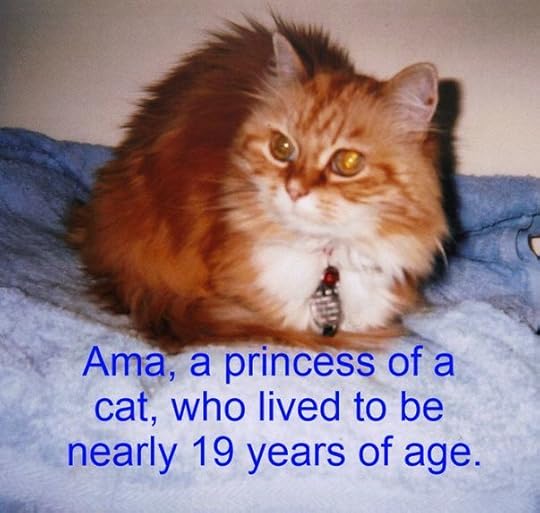
Published on July 18, 2017 05:00



